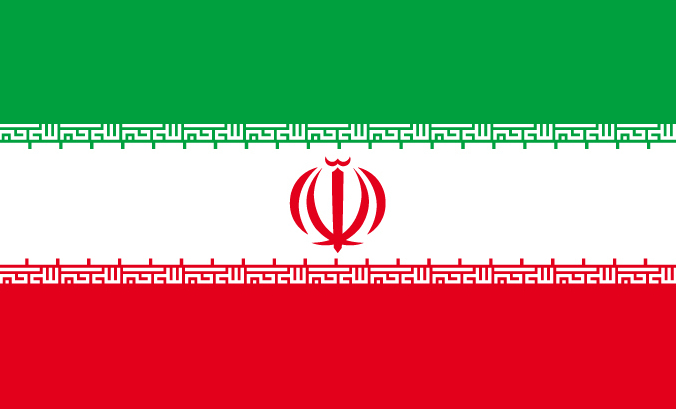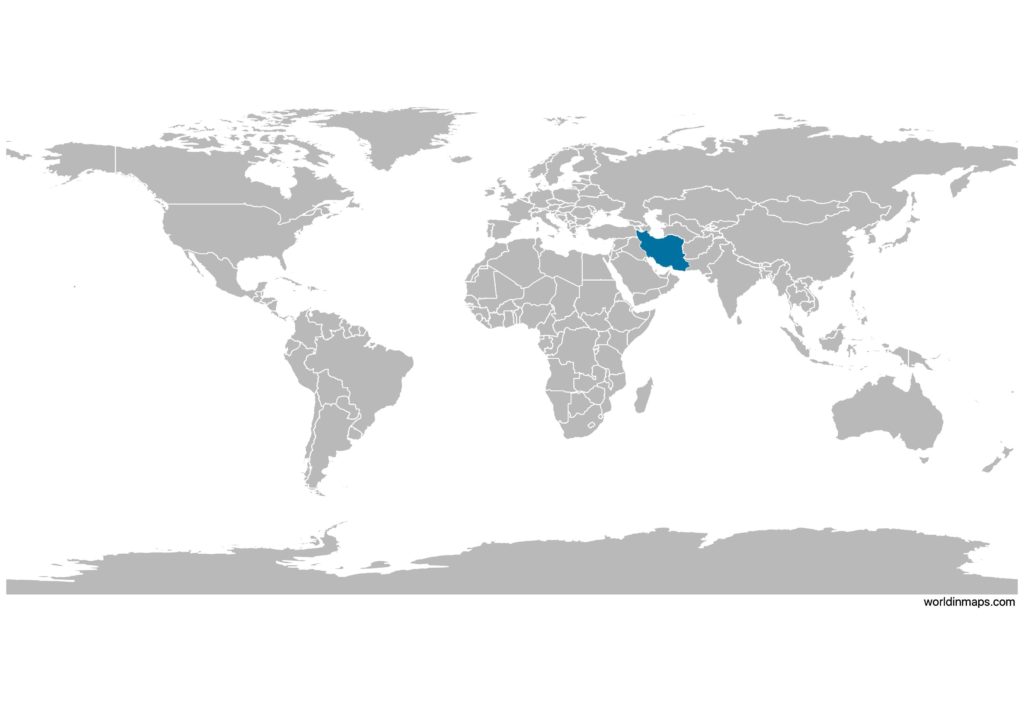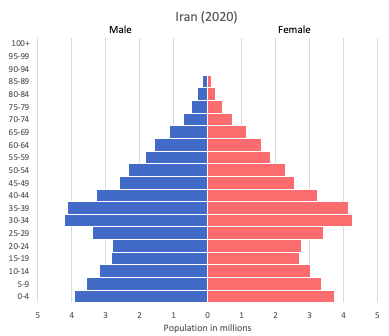Iran

| Government | |
| Name | Islamic Republic of Iran |
| Persian | جمهوری اسلامی ایران Jomhuri-ye Eslāmi-ye Irān |
| Government type | Theocratic republic |
| Capital | Tehran (8,693,706 (2016)) |
| Currency | Rial (IRR) |
| Organization | |
| Observer State | South Asian Association for Regional Cooperation (SAARC) |
| People | |
| Population (2020) | 83,992,953 (17th) |
| Density of population | 48 P/km2 (162nd) |
| Nationality | Iranian |
| Official languages | |
| Persian (Persian Farsi) | |
| Ethnic groups | |
| Persian | |
| Azeri | |
| Kurd | |
| Lur | |
| Baloch | |
| Arab | |
| Turkmen | |
| Turkic | |
| Religions (2011) | |
| Muslim (official) | 99.4% |
| Shia | 90-95% |
| Sunni | 5-10% |
| Other | 0.3% |
| Unspecified | 0.4% |
| Life expectancy (2020) | |
| Male | 73.1 years |
| Female | 76 years |
| Total population | 74.5 years (131st) |
| Homicides | |
| Total (2014) | 2.5 per 100,000 people (90th) |
| Geography | |
| Land area | 1,531,595 km2 |
| water area | 116,600 km2 |
| total area | 1,648,195 km2 (19th) |
| Mean elevation | 1,305 m |
| Lowest point | |
| Caspian Sea | -28 m |
| Highest point | |
| Kuh-e Damavand | 5,625 m |
| Land use (2011) | |
| Agricultural land | 30.1% |
| Arable land | 10.8% |
| Permanent crops | 1.2% |
| Permanent pasture | 18.1% |
| Forest | 6.8% |
| Other | 63.1% |
| Urbanization | |
| Urban population (2020) | 75.9% |
| Rate of urbanization | 1.71% annual rate of change (2015 – 2020) |
| Economy | |
| Labor force (2017) | 30.5 million (21st) |
| note: shortage of skilled labor | |
| Labor force by occupation (2013) | |
| Agriculture | 16.3% |
| Industry | 35.1% |
| Services | 48.6% |
| Unemployment rate (2017) | 11.8% (157th) |
| GDP (PPP) (estimate 2019) | |
| Total | $1.471 trillion (18th) |
| Per capita | $17,662 (66th) |
| GDP (nominal) (estimate 2019) | |
| Total | $458.500 billion (25th) |
| Per capita | $5,506 (95th) |
| GDP by sector (estimate 2016) | |
| Agriculture | 9.6% |
| Industry | 35.3% |
| Services | 55.1% |
| Exports (2017) | $101.4 billion (37th) |
| Exports partners (2017) | |
| China | 27.5% |
| India | 15.1% |
| South Korea | 11.4% |
| Turkey | 11.1% |
| Italy | 5.7% |
| Japan | 5.3% |
| Imports (2017) | $76.39 billion (44th) |
| Imports partners (2017) | |
| UAE | 29.8% |
| China | 12.7% |
| Turkey | 4.4% |
| South Korea | 4% |
| Germany | 4% |
Iran on the world map

Iran is located in Asia and more specifically in the Middle East.
Iran top 10 largest cities (2016)
- Tehran (8,693,706)
- Mashhad (3,001,184)
- Isfahan (1,961,260)
- Karaj (1,592,492)
- Shiraz (1,565,572)
- Tabriz (1,558,693)
- Qom (1,201,158)
- Ahvaz (1,184,788)
- Kermanshah (946,651)
- Urmia (736,224)
Demography
Population pyramid

Age structure data
Estimate for 2020:
- 0-14 years: 24.11% (male 10,472,844/female 10,000,028)
- 15-24 years: 13.36% (male 5,806,034/female 5,537,561)
- 25-54 years: 48.94% (male 21,235,038/female 20,327,384)
- 55-64 years: 7.72% (male 3,220,074/female 3,337,420)
- 65 years and over: 5.87% (male 2,316,677/female 2,670,254)
Remark: the age structure of a population affects a nation’s key socioeconomic issues. Countries with young populations (high percentage under age 15) need to invest more in schools, while countries with older populations (high percentage ages 65 and over) need to invest more in the health sector. The age structure can also be used to help predict potential political issues. For example, the rapid growth of a young adult population unable to find employment can lead to unrest.
Population from 1950 to 2020
Source: United Nations, Department of Economic and Social Affairs, Population Division (2019). World Population Prospects 2019, Online Edition. Rev. 1.
Evolution of the life expectancy from 1960 to 2018
Source: World Development Indicators, The World Bank
Economy
Agriculture:
wheat, rice, other grains, sugar beets, sugarcane, fruits, nuts, cotton, dairy products, wool, caviar
Industries:
petroleum, petrochemicals, gas, fertilizer, caustic soda, textiles, cement and other construction materials, food processing (particularly sugar refining and vegetable oil production), ferrous and nonferrous metal fabrication, armaments
Exports – commodities:
petroleum 60%, chemical and petrochemical products, fruits and nuts, carpets, cement, ore
Imports – commodities:
industrial supplies, capital goods, foodstuffs and other consumer goods, technical services
Time zone and current time in Iran
Go to our interactive map to get the current time in Iran